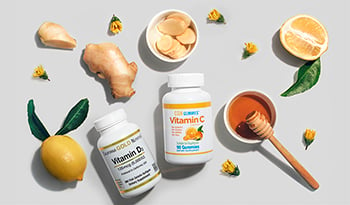Make These 5 Simple Resolutions for Health and Immunity This Year
DISCLAIMER:This blog does not intend to provide diagnosis...
- In this article:
- 1. Optimize Your Sleep
- 2. Check Your Vitamin Levels
- 3. Commit to Moving More Regularly
- 4. Breathe Deeper
- 5. Add More Joy to Your Life

The New Year is a great time to set intentions for the months ahead and to make detailed plans for accomplishing them. As a naturopathic doctor, I know that it is far easier to accomplish your goals when your health is on point. So, here are my recommendations for wellness practices to implement in 2021 that will allow you to thrive and outperform even your loftiest goals.
First, start with the foundations of health: sleep, movement, and nutrition. Then, build on your foundation with connection, joy, and confidence.
1. Optimize Your Sleep
Poor sleep is associated with an increased risk of a number of chronic and debilitating illnesses, including cardiovascular disease, cancer, depression, and even decreased lifespan. Inadequate sleep also makes it harder to concentrate, make good food choices, and exercise safely, so it’ll get in the way of reaching your other resolutions if it goes unchecked!
My advice if you haven’t been sleeping well is to commit to giving yourself the gift of a longer, healthier, and more joyful life by optimizing your sleep this year. If you’ve got a legitimate sleep disorder or insomnia that’s preventing you from getting adequate rest, see your doctor for specialized testing and treatment. Otherwise, you can start by committing to fixing the things that are within your control—your bedtime, sleep hygiene, and sleep nutrition.
The best way to stick to a regular bedtime is to create a routine. Set an alarm with gentle sounds to go off about an hour before you’d like to be asleep. This should be your cue to put down electronics, take a shower or bath with products that contain calming essential oils, or brew a pot of a relaxing herbal tea.
Keep your room as dark as possible by turning off all lights and electronics and using blackout curtains to block out light from the outdoors. If that’s not possible, use a sleep mask to make sure the light doesn’t reach your eyes. Keeping your room as dark as possible is important to allow your body to make its own melatonin, which is the hormone that tells your body it’s time to fall asleep and stay asleep.
If you work from home and find that this has contributed to your sleep schedule being out of whack, check out the Resetting Your Sleep Schedule article and accompanying video for more information on this topic.
2. Check Your Vitamin Levels
The CDC (Centers for Disease Control and Prevention) conducts a study each year called The National Health and Nutrition Examination Survey to measure inadequate nutrient intake and nutrient deficiencies in the U.S. population. And… surprise! Fully 10 percent of U.S. adults are deficient in vitamin B6 and iron. That’s a lot of people!
Side effects of these deficiencies include fatigue, depression, low immune function, skin rashes, and more. Do you have any of these? If so, it’s worth considering if you may be low in those nutrients and asking your doctor to test you.
The Second National Report on Biochemical Indicators of Diet and Nutrition in the U.S. Population found other common deficiencies in the U.S. population as well. Between 8-30% of adults in America are deficient in vitamin D. Six percent are deficient in vitamin C. Before the folate fortification efforts in the late 1990s, a significant portion of the population was also deficient in folate.
No one else can make sure that you’re not deficient in these vitamins and minerals except you. You owe it to yourself and your future health to ask your doctor to help you make sure you’re getting enough of these from your diet, and to help you supplement if it appears that you’re not. Taking a multivitamin is a safe and effective way to ensure you get the recommended amount of each of these vitamins and minerals every day.
Following the old adage to eat at least five fruits and veggies each day is also an easy, delicious way for you to increase the number of antioxidants, vitamins, and minerals in your diet. If you find that your fruit goes bad quickly, don’t worry! Add some trail mix, freeze-dried fruit, soups, and chilis into your life, and watch your total intake for the rise effortlessly.
3. Commit to Moving More Regularly
Many of us feel like if we’re not giving our all at the gym, our exercise doesn’t count. That couldn’t be further from the truth! The American Heart Association recommends 150 minutes of moderate-intensity exercise each week to maintain the health of your cardiovascular system. That’s about 30 minutes, five times per week. You can get that by doing an outdoor hike, online dance video, yoga class, or even playing outside with the kids.
If you’re someone who has a hard time sticking to a consistent movement schedule, consider setting times in your calendar and combining movement with community by joining a club or participating in a competition to get yourself motivated. Invest in some good foot care, build out your ideal music playlist, and try a new type of exercise to keep things exciting, fun, and feeling like true self-care.
4. Breathe Deeper
Oxygen is our most vital nutrient. Many people have dysfunctional breathing patterns that impair their ability to oxygenate their cells. If you tend to hyperventilate, then you’re familiar with the side effects of that condition, which can include feelings of anxiety, tightness around your chest, numbness, and tingling around your mouth and in your hands and feet.
The good news is that you can retrain your breathing patterns through meditation and deep breathing using a breath timer. There are tons of free apps online that can help you, and just as many free meditation videos to help. Commit to training or meditating for at least twenty minutes daily to see a shift in your breathing and, as a result, your peace of mind.
Additionally, making sure that the air in your home is clean and fresh is an important aspect of staying healthy. Use healthy air fresheners that contain only essential oils and no harsh chemicals if you must spray a scent. Open windows occasionally to let in the fresh air and change your air filters regularly. If you exercise along crowded highways or streets with tons of traffic, consider wearing a face mask to reduce the number of airborne particles you inhale while moving.
5. Add More Joy to Your Life
It takes some intention to add joy, particularly during times in our lives when things are tough. Adding more joy for yourself may look like including more small things that make you smile. Maybe it’s looking at old pictures, or listening to beautiful or fun music. It could be smelling your favorite scents, or just taking a break to go out into nature.
Adding more joy for others is actually an incredible way to also add joy for yourself. There’s an abundance of evidence that altruism—or helping others—is incredibly good for your mental and physical health. Compassion for both ourselves and others has also been found to increase biomarkers of wellness in every system, from the immune system to the cardiovascular system.
In the same way that you should take 30 seconds once a day to add joy to your own life, make sure to add joy to someone else’s life for even just a few moments. A small note, text, card, or call can make the difference and boost your own mood.
It’s my hope that this article will help to inform your 2021 resolutions and allow you to succeed in every aspect of your life. Remember to start with the foundations of sleep, movement, and nutrition. From there, build on your foundation with breathwork, connection, and joy. If you do all this, 2021 just might be your best year yet.
References:
- About NCHS Nutrition Data. Accessed December 15, 2020. https://www.cdc.gov/nchs/data/factsheets/factsheet_nutrition_data.pdf
- Centers for Disease Control and Prevention, National Center for Environmental Health, Division of Laboratory Sciences. CDC’s Second Nutrition Report: A Comprehensive Biochemical Assessment of the Nutrition Status of the U.S. Population Report Measures 58 Indicators of Diet and Nutrition New Report Uses NHANES Results.; 2012. https://www.cdc.gov/nutritionreport/pdf/4page_%202nd%20nutrition%20report_508_032912.pdf
- Appendix 1. Physical Activity Guidelines for Americans - 2015-2020 Dietary Guidelines | health.gov. Health.gov. Published 2015. Accessed December 15, 2020. https://health.gov/our-work/food-nutrition/2015-2020-dietary-guidelines/guidelines/appendix-1/#:~:text=For%20substantial%20health%20benefits%2C%20adults,and%20vigorous%2Dintensity%20aerobic%20activity.

 By Dr. Kate Henry, N.D.
By Dr. Kate Henry, N.D.


